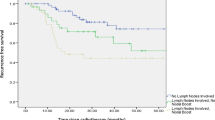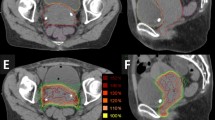Abstract
Purpose
We investigated the effect of boost radiation therapy (RT) in addition to whole pelvis RT (WPRT) on treatment outcome and safety of cervical cancer patients following hysterectomy with close/positive resection margins (RM).
Methods
We retrospectively analyzed 51 patients with cervical cancer who received WPRT with or without boost-RT as adjuvant treatment between July 2006 and June 2022. Twenty patients (39.2%) were treated with WPRT-alone, and 31 (60.8%) received boost-RT after WPRT using brachytherapy or intensity-modulated RT.
Results
The median follow-up period was 41 months. According to RT modality, the 4-year local control (LC) and locoregional control (LRC) rates of patients treated with WPRT-alone were 61% and 61%, respectively, whereas those in LC and LRC rates in patients who underwent WPRT with boost-RT were 93.2% and 75.3%, with p-values equal to 0.005 and 0.090, respectively. Seven patients (35.0%) had local recurrence in the WPRT-treated group compared to only two out of the 31 patients (6.5%) in the WPRT with boost-RT-treated counterparts (p = 0.025). Boost-RT was a significantly good prognostic factor for LC (p = 0.013) and LRC (p = 0.013). Boost-RT did not result in statistically-significant improvements in progression-free survival or overall survival. The acute and late toxicity rates were not significantly different between groups.
Conclusion
Boost RT following WPRT is a safe and effective treatment strategy to improve LC without increasing toxicity in patients with cervical cancer with close/positive RM after hysterectomy.

Similar content being viewed by others
Data availability
Data are available upon reasonable request.
References
Zhao H, He Y, Yang SL, Zhao Q, Wu YM. Neoadjuvant chemotherapy with radical surgery vs radical surgery alone for cervical cancer: a systematic review and meta-analysis. Onco Targets Ther. 2019;12:1881–91.
Ramirez PT, Frumovitz M, Pareja R, Lopez A, Vieira M, Ribeiro R, et al. Minimally invasive versus abdominal radical hysterectomy for cervical cancer. N Engl J Med. 2018;379:1895–904.
Uppal S, Gehrig PA, Peng K, Bixel KL, Matsuo K, Vetter MH, et al. Recurrence rates in patients with cervical cancer treated with abdominal versus minimally invasive radical hysterectomy: a multi-institutional retrospective review study. J Clin Oncol. 2020;38:1030–40.
Samlal RA, van der Velden J, Schilthuis MS, González González D, Ten Kate FJ, Hart AA, et al. Identification of high-risk groups among node-positive patients with stage IB and IIA cervical carcinoma. Gynecol Oncol. 1997;64:463–7.
Orosco RK, Tapia VJ, Califano JA, Clary B, Cohen EEW, Kane C, et al. Positive surgical margins in the 10 most common solid cancers. Sci Rep. 2018;8:5686.
Viswanathan AN, Lee H, Hanson E, Berkowitz RS, Crum CP. Influence of margin status and radiation on recurrence after radical hysterectomy in Stage IB cervical cancer. Int J Radiat Oncol Biol Phys. 2006;65:1501–7.
Kim YJ, Lee KJ, Park KR, Kim J, Jung W, Lee R, et al. Prognostic analysis of uterine cervical cancer treated with postoperative radiotherapy: importance of positive or close parametrial resection margin. Radiat Oncol J. 2015;33:109–16.
Small W Jr, Beriwal S, Demanes DJ, Dusenbery KE, Eifel P, Erickson B, et al. American Brachytherapy Society consensus guidelines for adjuvant vaginal cuff brachytherapy after hysterectomy. Brachytherapy. 2012;11:58–67.
National Comprehensive Cancer Network. Cervical cancer (Version 1.2023). 2023. https://www.nccn.org/professionals/physician_gls/pdf/cervical.pdf. Accessed 15 Jan 2023.
National Cancer Institute. Common Terminology Criteria for Adverse Events v5.0. https://ctep.cancer.gov/protocoldevelopment/electronic_applications/docs/ctcae_v5_quick_reference_5x7.pdf. Accessed 15 Jan 2023.
Lee SI, Atri M. 2018 FIGO staging system for uterine cervical cancer: enter cross-sectional imaging. Radiology. 2019;292:15–24.
Kim D, Ki Y, Kim W, Park D, Lee J, Lee J, et al. Adjuvant external beam radiation and brachytherapy for vaginal resection margin positive cervical cancer. Radiat Oncol J. 2018;36:147–52.
Lee YH, Kim YS, Choi KH, Sung S, Jeong BK, Ha IB, et al. Comparison of treatment outcomes of pelvis external radiotherapy with and without vaginal brachytherapy for cervical cancer patients with positive or close vaginal resected margins. Int J Clin Oncol. 2022;27:202–12.
Ager BJ, Torgeson A, Francis SR, Burt LM, Gaffney DK, Cannon DM. Impact of brachytherapy boost and dose-escalated external beam radiotherapy in margin positive cervical cancer treated with chemotherapy and radiation. Am J Clin Oncol. 2020;43:35–42.
Stock RG, Chen AS, Flickinger JC, Kalnicki S, Seski J. Node-positive cervical cancer: impact of pelvic irradiation and patterns of failure. Int J Radiat Oncol Biol Phys. 1995;31:31–6.
Contreras J, Srivastava A, Chundury A, Schwarz JK, Markovina S, Thaker PH, et al. Long-term outcomes of intensity-modulated radiation therapy (IMRT) and high dose rate brachytherapy as adjuvant therapy after radical hysterectomy for cervical cancer. Int J Gynecol Cancer. 2020;30:1157–61.
Gynecologic Oncology Group. Chemotherapy and pelvic radiation therapy with or without additional chemotherapy in treating patients with high-risk early-stage cervical cancer after radical hysterectomy. NLM identifier: NCT00980954. https://clinicaltrials.gov/ct2/show/NCT00980954 Accessed 10 Jan 2023.
Takeda N, Sakuragi N, Takeda M, Okamoto K, Kuwabara M, Negishi H, et al. Multivariate analysis of histopathologic prognostic factors for invasive cervical cancer treated with radical hysterectomy and systematic retroperitoneal lymphadenectomy. Acta Obstet Gynecol Scand. 2002;81:1144–51.
Kamura T, Tsukamoto N, Tsuruchi N, Saito T, Matsuyama T, Akazawa K, et al. Multivariate analysis of the histopathologic prognostic factors of cervical cancer in patients undergoing radical hysterectomy. Cancer. 1992;69:181–6.
Du R, Li L, Ma S, Tan X, Zhong S, Wu M. Lymph nodes metastasis in cervical cancer: incidences, risk factors, consequences and imaging evaluations. Asia Pac J Clin Oncol. 2018;14:e380–5.
Koh WJ, Panwala K, Greer B. Adjuvant therapy for high-risk, early stage cervical cancer. Semin Radiat Oncol. 2000;10:51–60.
Guo Q, Zhu J, Wu Y, Wen H, Xia L, Ju X, et al. Validation of the prognostic value of various lymph node staging systems for cervical squamous cell carcinoma following radical surgery: a single-center analysis of 3732 patients. Ann Transl Med. 2020;8:485.
Lai CH, Hsueh S, Hong JH, Chang TC, Tseng CJ, Chou HH, et al. Are adenocarcinomas and adenosquamous carcinomas different from squamous carcinomas in stage IB and II cervical cancer patients undergoing primary radical surgery? Int J Gynecol Cancer. 1999;9:28–36.
Van de Putte G, Lie AK, Vach W, Baekelandt M, Kristensen GB. Risk grouping in stage IB squamous cell cervical carcinoma. Gynecol Oncol. 2005;99:106–12.
Takekuma M, Kasamatsu Y, Kado N, Kuji S, Tanaka A, Takahashi N, et al. The issues regarding postoperative adjuvant therapy and prognostic risk factors for patients with stage I-II cervical cancer: a review. J Obstet Gynaecol Res. 2017;43:617–26.
Ryu SY, Kim MH, Nam BH, Lee TS, Song ES, Park CY, et al. Intermediate-risk grouping of cervical cancer patients treated with radical hysterectomy: a Korean gynecologic oncology group study. Br J Cancer. 2014;110:278–85.
Landoni F, Maneo A, Cormio G, Perego P, Milani R, Caruso O, et al. Class II versus class III radical hysterectomy in stage IB-IIA cervical cancer: a prospective randomized study. Gynecol Oncol. 2001;80:3–12.
Matsuo K, Mandelbaum RS, Machida H, Purushotham S, Grubbs BH, Roman LD, et al. Association of tumor differentiation grade and survival of women with squamous cell carcinoma of the uterine cervix. J Gynecol Oncol. 2018. https://doi.org/10.3802/jgo.2018.29.e91.
Author information
Authors and Affiliations
Contributions
HJK contributed to the study conception and design. Material preparation, data collection and analysis were performed by HJK, MK, Y-KK, and SJL. The first draft of the manuscript was written by SJL. All authors reviewed and approved the final manuscript.
Corresponding author
Ethics declarations
Conflict of interest
None.
Ethical approval
This study was approved by the institutional review board of the Catholic Medical Center ethics committee (IRB No.: OC22RASI0154).
Informed consent
No informed consent was required for this study.
Additional information
Publisher's Note
Springer Nature remains neutral with regard to jurisdictional claims in published maps and institutional affiliations.
Rights and permissions
Springer Nature or its licensor (e.g. a society or other partner) holds exclusive rights to this article under a publishing agreement with the author(s) or other rightsholder(s); author self-archiving of the accepted manuscript version of this article is solely governed by the terms of such publishing agreement and applicable law.
About this article
Cite this article
Lee, S.J., Kim, M., Kwak, YK. et al. The impact of boost radiation therapy after hysterectomy on cervical cancer patients with close or positive resection margins. Clin Transl Oncol 26, 689–697 (2024). https://doi.org/10.1007/s12094-023-03283-6
Received:
Accepted:
Published:
Issue Date:
DOI: https://doi.org/10.1007/s12094-023-03283-6




